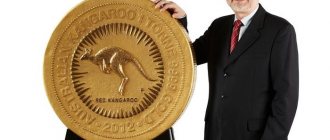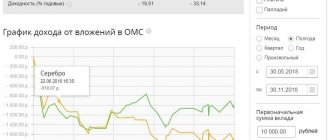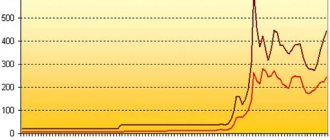Business
00:00, 24.11.2020 6
Gold sales abroad for 9 months exceeded the volumes for the entire last year, reaching $12 billion
Photo: finmarket.ru
As Realnoe Vremya calculated, Russian gold exports increased sevenfold over the first 9 months of the year. Its sales have already exceeded last year's volumes and amounted to more than $12 billion, while a third of the volumes of metal sold abroad occurred in September alone. Experts explained the trend by general instability in world markets, which naturally increases the demand for investors’ most favorite conservative asset. In addition, the autumn deterioration of the coronavirus epidemiological situation, as well as the new policy of the Central Bank, had a great impact. Of course, there is no talk of any sale of gold and foreign exchange reserves supposedly to cover shortfall in oil and gas revenues. Private gold mining companies trade the metal, and there is virtually no one to sell gold in such volumes (with annual production in Russia exceeding 300 tons) on the domestic market in the context of the coronavirus crisis and economic turmoil. With the growing demand for gold, the geography of exporting regions also expanded, so Kostroma was included in their number, where industrial mining of the precious metal began just a few years ago.
Main importers of Russian gold
Exports of Russian-produced gold have surged this year and continue to grow at rates comparable to the hyperinflation of the 1990s. In just 9 months, 211.4 tons of precious metal were exported from the country, or five (!) times more than during the same period last year (then the export volume did not exceed 40 tons).
In value terms, the volume of exports increased almost sevenfold: from 1.8 billion to 12.13 billion dollars. Higher rates and volumes of gold exports, of course, are associated with an increase in its quotations on world markets, which, in turn, is explained by the desire of global investors to invest in a more stable asset due to the general volatility of both currencies (dollar and euro) and other exchange assets, in particular oil and gas.
At the same time, the geography of importing countries has also expanded. Thus, a year ago, Russian gold was mainly sold to two countries known both for their developed exchange platforms, banking systems, and jewelry industry - the United Kingdom (primarily Great Britain) and Switzerland.
| Importing country | 9 months 2021 Weight, kg | 9 months 2021 Weight, kg | 9 months 2021 Cost, $ | 9 months 2021 Cost, $ |
| AM-ARMENIA | 3,0 | 152 370,0 | ||
| BY-BELARUS | 1,6 | 54 533,3 | ||
| CH-SWITZERLAND | 9 661,3 | 1 328,6 | 520 666 743,5 | 56 853 971,6 |
| GB-UNITED KINGDOM | 193 101,1 | 37 714,8 | 11 122 556 660,9 | 1 722 387 030,2 |
| HK-HONG KONG | 206,9 | 11 326 782,8 | ||
| IN-INDIA | 1 624,0 | 96 500 189,6 | ||
| TR-Türkiye | 6 859,7 | 377 235 791,1 | ||
| SG-SINGAPORE | 112,3 | 4 614 896,9 | ||
| CN-CHINA | 500,0 | 20 803 124,7 | ||
| TOTAL: | 211 457,6 | 39 655,7 | 12 128 493 071,2 | 1 804 659 023,4 |
| Growth | 4,3 | 5,7 |
London is home to the largest international gold trading centers. In particular, physical gold is traded on the London Bullion Market (LBM). The London Metal Exchange (LME) trades gold contracts, including futures and options.
Swiss Zurich became a major gold trading center in the 1970s. And since the early 1980s, Switzerland has imported between 1,200 and 1,400 tons of gold per year, exporting between 100 and 1,200 tons. Today, Switzerland imports up to 40% of the world's total gold supply, being its largest re-exporter (the gold is then resold to other countries). The three banks UBS, SBC and Credit Swiss are considered the most influential Swiss players in the gold market.
Russia is a major player in the global gold market
The September magazine of the World Gold Council, “Gold Investor,” contains an article by Tatyana Fick, director of the central banking and public policy department at this organization, dedicated to Russia’s place in the global gold market. We give its translation below.
Russia is the largest official buyer of gold in the world and ranks third in gold production. But Russia has still not fully realized its potential in terms of gold investment. This situation may change, especially if key reforms are implemented.
In 2021, the Central Bank of the Russian Federation (hereinafter referred to as the Central Bank) purchased 201 tons of gold, which significantly exceeds the volume of purchases by central banks of other countries. The People's Bank of China, for example, took second place, adding 80 tons to its reserves, while the National Bank of Kazakhstan is in third place with 36 tons.
Russia's interest in gold has been growing for years, but over the past decade it has reached new levels. During this time, the Central Bank added more than 1,250 tons of gold to its reserves, increasing them to 1,700 tons. Thus, Russia ranks sixth in gold reserves in the world. The volume of gold accounts for 17% of Russia's national wealth.
What explains Russia's interest in gold? Here are the words of Central Bank Chairman Elvira Nabiullina: “We adhere to the principle of reserve diversification. This principle remains unchanged. From this point of view, our reserves include gold." Dmitry Tulin, First Deputy Chairman of the Central Bank, also said that the Bank of Russia is increasing the amount of gold in its reserves to the extent that it is the only reserve asset that provides complete protection against legal and political risks.
Representatives of Gokhran of Russia - a government agency under the Ministry of Finance, whose gold reserves form part of the country's official gold reserves - believe that "gold is one of the most effective investment assets in the long term, and large volumes of gold purchased by both official and private investors in around the world, indicate the increased attractiveness of this asset. Gold has quintupled in value over the past 15 years, although it can fluctuate wildly in the short term. Gokhran reacts promptly to this changing situation in the global gold market, so when favorable market conditions occur, we replenish our gold reserves.”
Russia is not only the largest official buyer of gold, but also one of the leading gold producers
Gold production in Russia has almost doubled since 1995, so today the country ranks third after China and Australia in the list of global gold producing countries. Over the past ten years alone, more than 2,000 tons of gold have been mined in the country, and this year production is projected to be more than 300 tons; while by 2030 this figure is expected to rise to 400 tons. This is stated by the Chairman of the Union of Gold Miners of Russia Sergei Kashuba.
The growth in production is due to a number of factors, in particular, the privatization of previously state-controlled gold mining companies and the consolidation of small gold producers. These two circumstances have allowed Russian gold miners to compete on the world stage. According to the Union, the five largest gold miners, Polymetal, Kinross, Petropavlovsk and Nordgold, produce more than 120 tons of gold per year, which is about 50% of the total gold production in Russia.
Seven of the eight gold processing companies in Russia are on the London Bullion Market Association's Reliable Supply list. Only Japan and China have a better situation. However, production capacities in Russia are not used to their full potential. Thus, Krastsvetmet, the largest refinery in Russia, refines about 170 tons of gold per year, despite the fact that its production capacity allows it to refine approximately 250 tons. A similar situation is observed at all refineries.
Despite the positive trends, the volume of private investment remains at a low level, reaching only four tons last year.
For comparison: in China the volume of private investment amounted to 285 tons, in Germany - 105 tons, in the USA - 93 tons.
Russian investors are not interested in gold because purchases are subject to high taxes. The government, the Bank of Russia and commercial banks can purchase gold without paying VAT. But purchases of gold bullion by individuals and legal entities are subject to a VAT tax of 18%, which is the highest rate in the world. [It should be noted that in Russia gold investment coins, which can be bought, for example, at the Golden Coin House, are not subject to VAT - approx. trans.]
The gold mining industry and the Russian gold market will only benefit if this tax regime is changed. In July of this year, Anatoly Aksakov, Chairman of the Committee on Financial Markets in the State Duma, held a round table in parliament at which the issue of developing the Russian gold market was discussed, including the removal of VAT on gold bars purchased by private investors.
The round table was attended by Alexey Moiseev, Deputy Minister of Finance, representatives of the Union of Gold Miners, Krastsvetmet, Moscow Exchange, World Gold Council and large banks, including Otkritie Bank, Lanta-Bank and Sberbank. The event participants warmly supported the idea of removing VAT from gold. Marina Tseplyaeva from the Union of Gold Miners said the following at this meeting: “This [abolition of VAT – ed.] will dramatically increase the investment attractiveness of gold for Russians and increase the demand for physical gold.” The removal of VAT should increase retail demand for gold by approximately 50 tonnes per year in the long term, thereby strengthening the country's economic well-being.
A draft amendment to the Tax Code has now been submitted to the Russian government for consideration, and many hope that it will be approved.
Today Russia is a major player in the global gold market, both in terms of supply and demand. It is the third largest gold producer with a 200-year history of gold mining, and the most significant official buyer of gold. In our opinion, the opening of the domestic gold investment market can significantly strengthen the Russian economy and Russia’s position in the global gold market, and will also improve the situation in gold mining.
New importing countries
In the first 9 months of 2021, 37.7 tons of Russian gold worth $1.7 billion migrated to the British safes of banks, investors and jewelers. The Swiss went to 1.3 tons of gold worth $55.8 million. In this sense, they went to Singapore and China “pennies” (112 kg for $4.6 million and half a ton for $20.8 million, respectively).
In 2021, Hong Kong (where the the largest Asian gold trading center), where they sold 207 kilograms of the precious metal worth $11.3 million, India, which bought 1.6 tons of gold worth $96.5 million, and Turkey, where 6.8 tons worth $377.2 million were sold.
The London Metal Exchange (LME) trades gold contracts, including futures and options. Photo: Kreepin Deth/wikipedia.org
There are only a few Russian gold exporting regions, but what’s interesting is that if in 2017-2018 only a couple of regions of the country were selling abroad, now the geography of sellers has expanded. Thus, in 2021, gold was exported by the Sverdlovsk Region (just over four tons), Krasnoyarsk Territory (1.3 tons), Khabarovsk Territory (1.8 tons) and two resellers - Moscow and St. Petersburg. Then 57.7 tons were sold for export for $2.35 billion - mostly, again, to Switzerland (1 billion) and the UK (1 billion). The high volumes of gold exports were explained by high gold prices on world markets: 3 years ago, gold was trading at a price above $1,300 per troy ounce (one ounce is equal to approximately 31.1 grams of gold).
In 2021, only the Sverdlovsk region and the Krasnoyarsk Territory (plus Moscow) remained among the exporting regions. Due to the fall in the price of gold below $1,200 per ounce, only 16.6 tons were sold for export for $685.3 million.
Russia, one of the world's largest gold buyers, announced that it would suspend gold purchases starting at the beginning of this month. As the spread of the novel coronavirus pneumonia epidemic continues to increase global gold prices, Russia's decision has attracted widespread attention in the international market and various speculations have arisen. In an interview with Huanqiu Shibao on April 1, Wang Zhe, chief economist of China National Gold Group Corporation, said that Russia has large gold reserves, and the current decision to stop buying gold when its price is constantly rising is consistent with marketing logic.
Der Aktionär 04/01/2020 Fox News 09/10/2019 SwissInfo 03/30/2020
As reported, the Central Bank of Russia announced the cessation of gold purchases on the domestic precious metals market from April 1. As of March 1 of this year, Russia's gold reserves amounted to 2,300 tons of gold totaling $119.8 billion. Currently, the share of gold in Russian foreign exchange reserves is relatively high - 21%-22%. Already in the second half of 2021, Russia began to reduce the volume of gold purchases. Russian experts believe that such a decision by the Central Bank is predictable. Over the past five-plus years, Russia's gold reserves have more than doubled. There are currently no additional funds in the budget of the Russian Federation for the purchase of gold.
Wang Zhe said that Russia has announced to stop purchasing gold at this time for two reasons: on the one hand, since the price of gold is at a historically high level, Russia now does not want to continue investing in it. On the other hand, the share of Russian gold reserves is already relatively high, and we can say that the volume of Russian gold reserves has reached the appropriate level. In addition, due to the fall in world oil prices, Russia, being the largest oil-producing country, cannot continue to increase its gold reserves due to liquidity.
Recently, the global spread of coronavirus has increased market demand for gold, which is seen as a safe-haven asset. According to statistics, global gold prices rose by about 4% in the first quarter of 2021, recording continuous growth for six consecutive quarters, the longest period of rising gold prices since 2011. On April 1, the spot gold price briefly fell $7, marking the current low of $1,576.5 an ounce, but that is still an all-time high.
According to Bloomberg, with gold prices now near a seven-year all-time high and the fact that international investors are looking for safe-haven assets, Russian traders may begin to look to sell gold. Wang Zhe suggests that in the future, risk phobia will continue to support high gold prices, but shocks are not excluded.
Currently, the coronavirus epidemic has already affected international gold mining and transportation. According to a report by The Financial Times, three of the world's largest refineries, with a combined production capacity of 1/3 of the world's capacity, recently suspended gold production. With most flights cancelled, thousands of tons of gold bars sitting in vaults around the world are difficult to transport in a timely manner. Bloomberg reported on April 1 that retail sales of gold and silver in China fell 41% from January to February due to the impact of the epidemic. “Currently, Chinese investors are forced to use deposits to buy gold.” The recovery of the gold market is expected to be slow going forward.
InoSMI materials contain assessments exclusively of foreign media and do not reflect the position of the InoSMI editorial staff.
Kostroma has joined the Siberian gold miners
In 2021, the price of gold went up again, crossing the psychologically significant mark of $1.5 thousand per troy ounce. As a result, the geography of exporting regions instantly expanded: Irkutsk, Amur, Kostroma regions and Khabarovsk Territory were added to Sverdlovsk and Krasnoyarsk. Export volumes increased more than five times: gold bars weighing 116.2 tons worth $5.5 billion were sent abroad.
The appearance of Kostroma may be surprising (the Ural and Siberian regions have been famous for their gold reserves and mining for decades). In this region, gold mining began not so long ago; only at the very end of the 20th century the presence of sufficient gold reserves in the Kostroma subsoil was confirmed. Industrial mining began in 2013, when the state held two auctions for the right to develop the Chabra (projected reserves - 630 kg of placer gold) and Zastavskoye (reserves - 700 kg) sites. The total area of gold deposits in the region, according to local authorities, was about 2 thousand square meters. As a result, in 2021 Kostroma has already sold 4.8 tons of gold for export.
Experts attribute the decline in the share of precious metal exports to last year’s tragedy, when on October 19, 17 workers at the Sisim gold mining enterprise died due to a dam break. Photo: Main Directorate of the Ministry of Emergency Situations for the Krasnoyarsk Territory
How the dam tragedy deprived Krasnoyarsk residents of gold
We also note that despite the high quotations, the largest gold miner, the Krasnoyarsk Territory, has almost disappeared from the list of exporting regions. “The most golden region of Russia” this year sold a ridiculous 40 kg of gold abroad.
Experts attribute the decline in the share of precious metal exports to last year’s tragedy, when on October 19, a dam break killed 17 workers at the Sisim gold mining enterprise, and damage to the rivers amounted to 360 million rubles.
In January 2021, the Sibzoloto holding (one of the top 20 Russian gold miners) was stripped of its license to mine gold in the Bolshaya Seiba River basin. A massive inspection of hundreds of such enterprises took place in March 2021.
As it turned out, up to 60 tons of gold are mined annually in the Krasnoyarsk Territory, the bulk of which comes from large-scale gold, but at the same time up to 300 small licensed companies in the south of the region conduct their mining.
Gold mining in Russia - history
For modern Russia, gold mining is a very important industry. She remained without proper attention for quite a long time.
According to the official version, the mining of this precious metal began in the 18th century. A small pebble, found in the area of present-day Yekaterinburg by a schismatic, served as a start. For some unknown reason, the find was reported to the administration of the Yekaterinburg plant, and the search continued. Many more similar stones were discovered. Much later, the “Primary” gold mine appeared, on the very spot where the pebbles were found.
The foundation of the industry in the Russian Empire on a national scale was laid by Peter the Great in 1719. There is a mention in 1732 of a mine in the Arkhangelsk province, which produced 65 kg over the years of its existence.
Rice. 2. Gold mining two centuries ago Source: website aikido-mariel.ru
By the beginning of the 19th century, Russia was already a leader in the development and extraction of valuable metal. After the reform of S. Yu. Witte and the introduction of the “gold standard,” Russia began to mint gold coins, and foreign companies and private individuals were given access to the development of gold mines.
The Revolution and Civil War had a detrimental effect on the mines that developed during tsarist times. Gold mining found itself in a rut for many years.
The creation of the Committee on Precious Metals in 1918 did not help either. It was not possible to establish order, and a record of the mines was not created, but it turned out to be difficult to restore order and register the mines. The Urals and Siberia were the main gold mining areas. The new government did not get there right away. Moreover, the mines and mines changed owners every now and then: sometimes “white”, sometimes “red”. And they were not stingy in their desire to destroy the enemy. The confrontation ended with the almost complete destruction of the industry:
- 1913 – about 64 tons;
- 1918 – 30;
- 1920 – 2,8;
- 1921 – 2,5.
The Soviet period did not bring prosperity to the industry either. The state did not see its task as development. The state focused its attention not on the development of already discovered deposits and the exploration of new ones. It focused on expropriating gold and its products from the population. At the level of production at gold mines in the period 1918 - 1922. The Soviet government received about 15 tons of gold, while at the same time 15.7 tons of gold and products were confiscated from the population.
The monetary reform of 1921 was based on the “gold standard” formula, which meant that the gold reserve should become collateral for funds. But it is already clear that the reserves of the precious metal have been depleted, geological exploration data can no longer be found and there are no plans for new geological exploration.
The young Soviet state is trying to create a system of financing and encouraging private miners and small gold mining enterprises; in 1923, it began the development of Yakut gold in the Aldan River basin. They said that gold was almost collected there by hand.
The first results have also appeared. In 1929, more than 25 tons of pure gold were mined, most of which came from government organizations. During 1936-37, 130 tons were mined, which brought Russia to second place in the world. By the beginning of the Second World War, the treasury received an average of almost 174 tons per year.
Later, the industry had to go through difficult times. Information about its activities turned out to be classified for a long time. Economic recovery required emergency measures. And in the camp system, gold mining was carried out by prisoners serving sentences. Super-cheap labor very soon raised gold mining in the country to a fairly high level, and the price of that gold was human lives.
And during Brezhnev’s rule, the industry traditionally did not receive due attention. And only with perestroika the approach to supplying the industry was revised. And with the reorganization of 1988, the decline in volumes gave way to growth. Although it is difficult to call this period sustainable for gold mining. There were 330 tons from 1990, and 115 from 1998.
Rice. 3. A visual aid to the history of gold mining in Russia Source: website world.lib.ru
Gold rose in price by 25%
In 2021, the demand for gold, against the backdrop of general instability in the global economy and extreme volatility on stock exchanges, has increased significantly. Naturally, the price of the precious metal also increased (it always increases in price in turbulent times - and conservative investors love it very much).
The year began with gold prices over $1,600 per troy ounce; by the height of the first wave of the pandemic in April, the market value of gold reached $1,700 and after a short-term fever caused by the sale of gold assets (and the price falling below $1,500 per troy ounce), it continued to rise throughout the summer .
By the beginning of autumn, quotes reached a record 2000-2100 dollars per troy ounce. To date, the price has stabilized (some of the speculators who bought the metal at a high price at the peak of its price usually sell this asset to make a short-term profit - which causes the quotes to rebound downwards), but gold is still trading around $1,900.
The growth in exports follows the dynamics of gold prices. Photo: goldenlab.ru
Features of the Russian gold market
1. The state is in a privileged position as the main buyer of precious metals mined in the depths. It is government agencies that issue licenses to private gold mining companies. At the same time, the work of private miners continues to be prohibited. The exceptions are entrepreneurs and individuals who are official employees of licensed gold mining enterprises. All developments can be carried out on a plot of up to 0.15 square meters. m without the use of explosives at a depth of up to 5 meters. Gold mining licenses are issued on a competitive basis.
2. The market for the development of gold deposits and the purchase of gold is a closed structure regulated by the Federal Law “On Precious Metals and Precious Stones” dated March 26, 1998 N 41-FZ and a number of Decrees of the Government of the Russian Federation. The supply of precious metals is carried out within the framework of government orders with preferential purchasing status for state-owned enterprises.
3. The gold mining market infrastructure is characterized by poor technical development and insufficient financing. The country has the largest explored but not developed deposits in Buryatia and the Khabarovsk Territory.
4. Currently, there is a low demand for gold among private entities and individuals. The main buyer is the government, and the population does not feel the urge to invest in gold bars or coins offered by commercial banks. As for jewelry, in this segment, since 2010, there has been a noticeable drop in demand. Citizens stopped “hoarding” gold jewelry, as was the case in former times. Today there are many other more profitable ways to invest free finance.
5. The lack of competent stimulation of market participants by the main regulator, which is the state, hinders the development of the industry as a whole. We are talking, first of all, about lifting bans on frequent gold mining with the legalization of the “free bringing of gold”, which has been used semi-legally for a long time in the same Kolyma.
If we talk about industrial gold mining, the top five most “golden” regions of the country are as follows:
• Krasnodar region • Chukotka Autonomous Okrug • Magadan region • Amur region • Yakutia
It is here that about 93% of all Russian gold is mined, which replenishes the foreign exchange reserves of Gokhran and the Central Bank. Leading gold mining concerns are JSC Polyus Gold, JSC Polymetal, Nordgold Company, Kinross Gold Enterprise, JSC Yuzhuralzoloto, JSC Severstal.
The main buyers of gold are the Central Bank, Gokhran, and territorial state funds. The remainder is purchased by commercial banks, jewelry and industrial enterprises.
Export growth is affected by the pandemic situation
The growth in exports follows the dynamics of gold prices. Thus, in January 2020, only 8 tons of metal were sold for $400 million, in February - 8.1 tons for $413.4 million. In March, which was already unstable due to the global pandemic, 11.4 tons of gold worth $573.5 million were exported In the chaos of April, while half the country was in lockdown, exports increased significantly - 41.7 tons of metal worth $2.2 billion were already exported.
In the somewhat calmer May after self-isolation, only 23 tons of gold worth $1.2 billion were sold for export. In the summer months, when the world and Russia were confident that the pandemic was on the decline, and the economy and markets had picked up somewhat, export sales were stable (though still high). June exports: 22.5 tons of gold worth $1.2 billion were exported. July exports: 23 tons of gold worth $1.36 billion. August: 20 tons of gold worth $1.25 billion were exported.
In September, when Russia and the world as a whole were on the verge of the second wave of the pandemic (or, as doctors say, the first wave, intensified by seasonal diseases), the economy and markets shook again, and gold exports from Russia reached peak values. In just one month, 54 tons of gold bars worth $3.37 billion were sold. In fact, September alone accounted for almost a third of all export sales in 2021 (or a quarter by weight).
How did the new policy of the Central Bank affect
Even in the midst of summer, it became clear that for the first time in the history of modern Russia, revenues from gold exports exceeded revenues from gas exports, reaching $3.58 billion in April-May (in the second quarter, pipeline gas exports brought Russia only $3.5 billion in revenue). This was partly caused by the Central Bank’s refusal for an indefinite period to purchase gold on the domestic market, which Elvira Nabiullina’s department has been doing for the last 5 years, accumulating gold reserves worth $120 billion. Banks, to which mining companies are obliged to sell gold under loan agreements for the possibility of financing, had no choice but to send gold abroad. There is simply no one in Russia to buy it in such quantities. In addition to banks, in April 2021, gold producers themselves received the right to sell gold abroad, although they essentially did not have time to issue licenses for such sales in April-May.
The remaining part was purchased by the Central Bank in 2014-2019: about 60% of the gold mined by private companies went to the state. Photo: Ludvig14/wikipedia.org
This is confirmed by independent expert agencies; according to July data from the international auditing and consulting network FinExpertiza, the multiple increase in gold exports from Russia in the spring of 2020 was caused by two reasons: “increasing prices for the precious metal and the suspension of its purchases by the Bank of Russia.” At the same time, exports of other precious metals also increased, but not in such volumes: in particular, platinum (an increase of 26% to $1.64 billion) and silver (an increase of 18% to $73.6 million). Let us note that, of course, there is no talk of any sale of the gold and foreign exchange reserves of the Central Bank of the Russian Federation - this is also evidenced by the geography of the exporting regions, besides, the Bank of Russia only last year increased the share of gold in its gold and foreign exchange reserves to 20% (optimal, as it considers he, level). And it is possible to compensate for lost oil and gas revenues by selling gold and foreign exchange reserves (which, we note once again, the state did not do this year) only for a short time.
He doesn’t need gold: why did the Central Bank of Russia stimulate the export of the precious metal
The export of Russian gold has reached an important milestone: for the first time, revenues from it exceeded the total revenue from sales of pipeline gas abroad. What is happening in the gold markets of the country and the world?
Against the backdrop of an unprecedented pumping of global markets, primarily the American market, with liquidity in an attempt to restore falling demand, which suffered as a result of the quarantine actions of the governments of most countries of the world, the demand for physical gold has reached unprecedented levels. The nominal price itself exceeded previous records on Monday and set a symbolic level for our country at $1,945 per ounce.
Technical analysis indicates that levels of $2,000 and even $2,500 per ounce no longer seem so out of reach. The risk of global inflation and a collapse in financial asset values is becoming increasingly clear, with more and more investment banks advising their clients to invest in gold, noting the likelihood of negative real yields remaining on most government securities in the developed world.
Advertising on Forbes
At the same time, the traditional counterargument against the steady trend of increasing gold prices - a significant excess of current prices over the cost level - temporarily ceases to work, since pandemic risks and associated quarantine measures have affected a large number of mining countries. This creates a picture of rush demand for metal, the supply of which is also declining against the backdrop of current economic difficulties.
Against this background, the Central Bank of the Russian Federation refuses from April 2021 to buy gold, which it has been actively accumulating over the past 7 years. At the same time, the supply of gold for export from Russia has become more profitable than sales to domestic commercial banks, which traditionally buy gold from mining companies that receive loans from them. The result was not long in coming - in April 2021 alone, 41.8 tons of gold worth $2.2 billion were exported from Russia.
The physical volume of metal exports was 14 times higher than April 2021 deliveries. Taking into account May deliveries, which turned out to be significantly lower than April (20.7 tons), total gold exports from Russia for 5 months of 2021 amounted to 96.5 tons worth $5.1 billion. For comparison, for the entire 2021, 123.6 tons of gold worth $5.7 billion.
Some - although not very authoritative - commentators (for example, ,) began to talk about the actual sale of Russia's gold reserves against the backdrop of growing risks of depreciation of the US dollar. However, such speculation is at least premature. Chairman of the Central Bank Elvira Nabiullina said on April 24, 2021 that there is no need to talk about the beginning of a sale of gold reserves - the country has enough foreign exchange reserves to support imports and short-term debt in foreign currency.
At the same time, the refusal to purchase gold was explained by the desire to support the income of exporters, which decreased significantly after the fall in oil and gas prices. As a result, revenues from Russian gold exports in the second quarter exceeded revenues from Russian natural gas exports. Taking into account the fall in the country's export earnings, the Central Bank's refusal to purchase gold made it possible to attract additional currency into the country, as a result of which it was possible to reduce speculative pressure on the ruble during a period of extremely low prices for hydrocarbons on world markets caused by quarantine measures on a planetary scale.
As for Russian gold producers, judging by the above figures, they were able to fully switch to supplying metal abroad, which allowed them to continue working during this difficult period. Of course, at the beginning of the quarantine, there were certain difficulties with the supply of metal to consumers against the backdrop of a sharply reduced air traffic, but later special air traffic was organized, which made it possible to stabilize supplies.
Is there a danger to the country's gold and foreign exchange reserves? At the moment, such a risk is not visible. Firstly, the volume of Russian gold reserves is 2300 tons, worth $130.8 billion - this is 23% of the country’s total reserves, which is a very high figure compared to the central banks of other countries. Secondly, metal mining in Russia continues to grow. Thus, in 2019, its production amounted to 343.5 tons (+9.3% compared to 2021), while in Russia the technology of autoclave leaching of gold from refractory ores has finally taken root, which promises to involve a large number of previously unused deposits into economic circulation . Thirdly, high prices make the development of even the poorest deposits profitable, which allows individual producers, taking advantage of good market conditions, to develop the least promising areas with positive profitability.
Will gold always go up in price? History shows that it is not. Firstly, the volatility in this market is always quite high, since its volume is several times smaller than the oil and industrial and agricultural goods markets. Secondly, the high price forces more and more new players to seek their fortune in the “gold rush”, and modern mining technologies make it possible to mine even the most difficult and poor reserves. Thirdly, the development of electronic money and new industries will actively lure investors from reliable metal to more profitable investment instruments. In addition, investors' increasing focus on environmentally friendly investments may pose serious questions for the gold mining industry.
In this regard, the decision of the Central Bank to actually stimulate gold exports from Russia can be called timely. The main thing is that the funds received are spent on modernizing the domestic economy. Perhaps the Russian regulator, like Pushkin’s hero, who read Adam Smith, knows how to “judge how the state is getting rich, and how it lives, and why it doesn’t need gold when it has a simple product.”
The author's opinion may not coincide with the editor's point of view
There is simply no one to sell hundreds of tons of gold on the domestic market
The authors of another study from the Institute of International Political and Economic Strategies - RUSSTRAT believe that in 2020 “nothing extraordinary happened on the gold market,” which, although, to put it mildly, is controversial, there is some truth in this. Every year, private mining companies (the main ones are Polyus, Polymetal and Petropavlovskaya) extract more than 300 tons of gold, of which 60 to 100 tons go to medicine, the electronics industry, and jewelry (up to 40-50 tons).
The remaining part was purchased by the Central Bank in 2014-2019: about 60% of the gold mined by private companies went to the state. The rest was exported. Considering the annual increase in gold production (in 2021 they promise an increase of 12% to 360 tons in 2019) and a decrease in domestic demand caused by a decrease in the effective demand of the population during the pandemic, excess mined gold naturally goes to Western exchanges, which is also facilitated by an increase in quotations of the precious metal.
Sergey Afanasiev
BusinessEconomyInvestmentIndustryAnalytics









